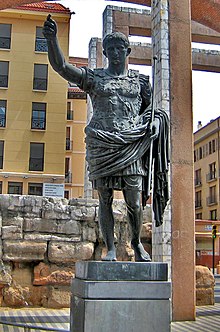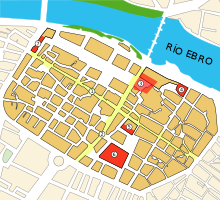| Caesaraugusta | |
|---|---|
 | |
| • Type | Roman Empire |
| History | |
• Established | 14 b.C. |
| Political subdivisions | Tarraconense |
| Today part of | |
Caesaraugusta or Caesar Augusta was the name of the Roman city of Zaragoza, founded as a Colonia Inmune from Rome in 14 BC,[1] possibly on December 23,[2] on the intensely Romanized Iberian city of Salduie.[3] Its foundation occurred in the context of the reorganization of the provinces of Hispania by Caesar Augustus after his victory in the Astur-Cantabrian wars.

1.- Decumano (present-day Calle Mayor, Calle Espoz y Mina and Calle Manifestación).
2.- Cardo (present-day Calle Don Jaime I)
3.- Forum of Caesaraugusta
4.- Fluvial port
5.- Public baths
6.- Theater
7.- Wall[4]
The new city received the name of "Colonia Caesar Augusta". It enjoyed the privilege of bearing the full name of its founder, who entrusted its deductio, like many other tasks of the Empire, to his general and close friend Marcus Vipsanius Agrippa.
Veteran soldiers of the legions IV Macedonica, VI Victrix and X Gemina, discharged after the hard campaign against the Asturians and Cantabrians, participated in the foundation of the city, with the double intention of guaranteeing the defense of the territory at the same time as establishing the presence of Rome in it. Zaragoza had the status of an Colonia Inmune, granting it certain privileges such as the right to mint coins or the exemption from paying taxes. The new citizens were attached to the Aniense tribe.
In the process of reorganization of Hispanic territories, three provinces were created, Tarraconense, Baetica and Lusitania, divided into juridical convents, minor districts with judicial and administrative functions; of these, the one governed by Caesaraugusta, the conventus juridicus Caesaraugustanus, was one of the largest of the seven into which the province of Tarraconense was divided. Caesaraugusta assumed from the beginning the role of regional head, replacing the colony Victrix Ivlia Celsa (in the current Velilla de Ebro).
The period of the city's greatest apogee in the first and second centuries brought many of the great public works, some of which can still be seen today: the forum, the river port, which made Caesaraugusta the main redistributor of goods in the Ebro valley, the public baths, the theater or the city's first bridge, located on the site of the current Stone Bridge and which was probably a work of ashlar or a mixture of stone and wood.
Water also played an important role in Roman Zaragoza, both for its location on the banks of the Ebro River and next to the mouth of the Huerva and Gállego rivers, as well as for its complex supply and irrigation systems. In addition to the aforementioned baths, a multitude of cisterns, fountains, sewers and various sections of lead and sanitation pipes have been documented.

- ^ Fatás, Guillermo (2008). Guía Histórico-Artística de Zaragoza (in Spanish) (4th ed.). Zaragoza: Institución «Fernando el Católico»-Ayto. de Zaragoza. pp. 669–708. ISBN 978-84-7820-948-4.
- ^ Mostalac Carrillo, Antonio; Biel Ibáñez, María Pilar (2008). Arqueología y Patrimonio histórico-artístico (1992-2008) (in Spanish). 670: Guillermo Fatás (dir.).
{{cite book}}: CS1 maint: location (link) - ^ Mostalac Carrillo and Biel Ibáñez, op. cit., chapter «Salduie/Salduvia (2nd century BC to 15-14 BC)», pp. 655-667.
- ^ The most recent research suggests the possibility that the wall, at least on the east side (where the city was better protected by the Huerva River), was built in the second half of the 3rd century, cf. Antonio Mostalac Carrillo and María Pilar Biel Ibáñez, loc. cit. in Guillermo Fatás (dir.), Guía Histórico-Artística de Zaragoza, ed. 2008, p. 678:
For many years it was believed that in Caesar Augusta there were two different walls [...] the older and, therefore, of the foundational period of the Colony, with a core of opus cæmenticium and an outer face of ashlars; and the second, dated to the 3rd century, with only ashlars. The colonial, in its most representative parts, must have been completed at the end of the 1st century, being one of the fundamental elements of the rank and prestige of Caesar Augusta.
However, in 2003, an important work of the whole of what was known so far of the wall [... ], allowed to assure its authors that the wall was possibly built in the second half of the 3rd century and that the execution technique was uniform: inner body of opus cæmenticium with outer covering of ashlar and thickness of 7 m; while the eastern side would be of ashlar with 6 m of thickness.— Mostalac and Biel (2008), p. 678.